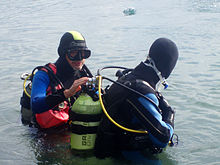Buddy (diving)
Buddy (from the American for 'buddy') refers to the diving partner with whom a dive is prepared, carried out and followed up on. In recreational diving , diving is usually done in the buddy system , because a reliable buddy who can help with problems is an essential safety factor when diving.
Buddy system
The dive is prepared and followed up together in a briefing and during the dive, contact with the buddy is kept constant by means of diving signs . Buddy teams are also usually formed in diving groups with several people. The tasks of Buddys teams include:
- each other while donning and doffing the diving equipment go hand
- Check the functionality of each other's equipment in the buddy check
- come to the aid of each other in emergency situations, in particular
- if your own air supply fails, provide breathing air (through an octopus on the device or alternating breathing )
- provide help with cramps
- In the event of injury or loss of consciousness, bring the partner safely ashore and call for medical assistance if necessary
- when getting stuck in obstacles (fishing lines, fishing nets, corals, etc.) instruct the partner how to free himself or how to cut him free with the diving knife
- pay attention to symptoms of deep intoxication, prevent the associated self-harm and direct the partner to a lower depth
- have a calming effect in fearful situations
The basic principle of the buddy system is the mutual consideration of the experience and abilities of the other and the equal or shared participation in the achievement of the goal pursued with the dive.
The training courses of the diving organizations place great importance on teaching the buddy system. In poor visibility conditions, contact with the buddy can be guaranteed with a partner leash, among other things . In principle, every diver in the buddy system is the backup diver of his buddy.
For solo diving, i.e. diving without a buddy, special requirements are placed on training and equipment that are not dealt with in the usual diving training . Some diving organizations completely oppose solo diving, but others offer special courses for it.
Individual evidence
- ↑ Thomas Kromp , Hans J. Roggenbach , Peter Bredebusch : Practice of diving . 3. Edition. Delius Klasing Verlag, Bielefeld 2008, ISBN 978-3-7688-1816-2 , p. 134 .
- ↑ Buddy system . ( Memento of the original from July 11, 2015 in the Internet Archive ) Info: The archive link was inserted automatically and has not yet been checked. Please check the original and archive link according to the instructions and then remove this notice. ct_lexikon, accessed on September 6, 2012.
- ↑ Buddy check: Tips & tricks for more safety when diving . ( Memento of the original from July 1, 2015 in the Internet Archive ) Info: The archive link was inserted automatically and has not yet been checked. Please check the original and archive link according to the instructions and then remove this notice. Online magazine Dekopause , October 28, 2013, accessed on July 1, 2015.
